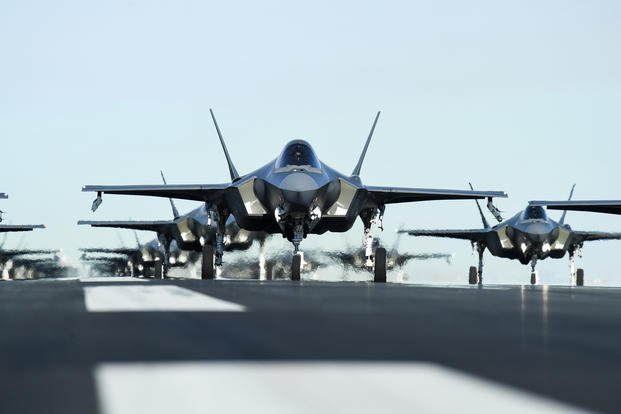Dozens of F-35 Joint Strike Fighters are down for engine repairs, top military officials disclosed Tuesday, as the services grapple with an engine shortage that has afflicted the Pentagon for more than a year.
Testifying before the House Subcommittee on Tactical Air and Land Forces, Air Force Lt. Gen. Eric Fick, who runs the F-35 program, disclosed that his service has been the hardest hit by the shortage.
As of July 8, the Air Force had 41 aircraft in what's known as "Mission Impaired Capability Awaiting Parts," or MICAP, status, for engines. That means the planes can't be used on missions until they're fixed. The service accepted its 283th F-35 in May.
Read Next: Security Is Lax at Major Arms Shipping Facilities, IG Finds
Fick said there are five other F-35s waiting for the repairs.
"I have three partner aircraft, I have one Marine Corps aircraft, and I have one U.S. Navy tail that are MICAP for an engine," he said during the hearing.
Some of those 46 aircraft are awaiting miscellaneous spare parts or are in need of upgraded F135 engine power modules, a component that improves the aircraft's thrust and performance, Fick said.
"We are also working closely with our industry and the Joint Strike Fighter organic engine heavy maintenance facility at Tinker Air Force Base [Oklahoma] on the depot repair recovery efforts," added Jay Stefany, acting assistant secretary of the Navy for research, development and acquisition. Tinker is home to the Oklahoma City-Air Logistics Complex, which oversees the repair work.
Those efforts include reducing the time jets sit in depot by adding more maintainer shifts to expedite the power module replacement, he said.
But some problems are related to a surface coating on the turbine blades that overheats, causing the blades to crack. A defense official first told Bloomberg News earlier this year that the engines require maintenance earlier than planned, taking them out of service sooner and exacerbating the shortage across the services.
Fick said Tuesday that there has been no setback in aircraft deliveries despite the engine shortage, adding that his office realized it was facing the problem early last year after repairs took longer than expected. The blade cracking presents an intricate issue, creating a backlog of aircraft needing attention, according to a report from Defense News.
As a direct impact of the engine shortage, Air Combat Command, which oversees fighter aircraft units, earlier this year decided to scale back its 2021 air show schedule for the F-35 to make sure the aircraft were available for deployments and training.
"There are two reasons -- COVID disruptions and [engine production] quality findings," Matthew Bromberg, president for military engines at Pratt & Whitney, a subsidiary of Raytheon Technologies, said in April.
He cited "COVID, Turkey, learning curve disruptions" as reasons the company needs to better manage its engine and spares production.
In 2019, the Pentagon officially booted Turkey from the F-35 program over its purchase of the Russian-made S-400 surface-to-air missile system; as a result, the Defense Department also began phasing it out of the supply chain.
Turkish industries produced roughly 1,000 parts for the F-35, including 188 associated with the engine, Bromberg said at the time.
A spokesman for Pratt & Whitney said the company has made significant progress in recent months to reduce the amount of time it takes to repair its engines and is on track to produce double the number of power modules than it did in all of 2020.
In an email sent to Military.com after this article's initial publication, the spokesman said that a lack of repair depot space is driving the delays, "NOT the reliability of the engine."
-- Editor's note: This story has been updated to include comments from Pratt & Whitney.
-- Oriana Pawlyk can be reached at oriana.pawlyk@military.com. Follow her on Twitter at @Oriana0214.
Related: Congress May Put the Kibosh on Buying Extra F-35 Fighter Jets












